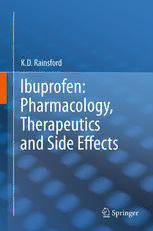
Ibuprofen: Pharmacology, Therapeutics and Side Effects PDF
Preview Ibuprofen: Pharmacology, Therapeutics and Side Effects
Ibuprofen: Pharmacology, Therapeutics and Side Effects . K.D. Rainsford Ibuprofen: Pharmacology, Therapeutics and Side Effects K.D.Rainsford BiomedicalResearchCentre SheffieldHallamUniversity Sheffield UnitedKingdom ISBN978-3-0348-0495-0 ISBN978-3-0348-0496-7(eBook) DOI10.1007/978-3-0348-0496-7 SpringerHeidelbergNewYorkDordrechtLondon LibraryofCongressControlNumber:2012951702 #SpringerBasel2012 Thisworkissubjecttocopyright.AllrightsarereservedbythePublisher,whetherthewholeorpart of the material is concerned, specifically the rights of translation, reprinting, reuse of illustrations, recitation,broadcasting,reproductiononmicrofilmsorinanyotherphysicalway,andtransmissionor informationstorageandretrieval,electronicadaptation,computersoftware,orbysimilarordissimilar methodologynowknownorhereafterdeveloped.Exemptedfromthislegalreservationarebriefexcerpts inconnectionwithreviewsorscholarlyanalysisormaterialsuppliedspecificallyforthepurposeofbeing enteredandexecutedonacomputersystem,forexclusiveusebythepurchaserofthework.Duplication ofthispublicationorpartsthereofispermittedonlyundertheprovisionsoftheCopyrightLawofthe Publisher’s location, in its current version, and permission for use must always be obtained from Springer.PermissionsforusemaybeobtainedthroughRightsLinkattheCopyrightClearanceCenter. ViolationsareliabletoprosecutionundertherespectiveCopyrightLaw. The use of general descriptive names, registered names, trademarks, service marks, etc. in this publicationdoesnotimply,evenintheabsenceofaspecificstatement,thatsuchnamesareexempt fromtherelevantprotectivelawsandregulationsandthereforefreeforgeneraluse. While the advice and information in this book are believed to be true and accurate at the date of publication,neithertheauthorsnortheeditorsnorthepublishercanacceptanylegalresponsibilityfor anyerrorsoromissionsthatmaybemade.Thepublishermakesnowarranty,expressorimplied,with respecttothematerialcontainedherein. Printedonacid-freepaper SpringerispartofSpringerScience+BusinessMedia(www.springer.com) This book is respectfully dedicated to Professor Stewart Adams OBE and his colleagues for their discovery of ibuprofen 50 years ago and its implementation in the therapy of pain and inflammatory conditions. Professor Stewart Adams, BPharm, PhD, DSc(hc), OBE . Foreword I am very pleased to write the foreword to this book, since Professor Rainsford overtheyearshaswrittenextensivelyandexpertlyonibuprofen.Itisdifficultnow to look back to 1953 when I first began to think about the possibility of finding a non-corticosteroid drug for the treatment of rheumatoid arthritis (RA). It was a forbidding prospect, for little was known about the disease process and nothing about the mode of action of aspirin (aspirin being effective in very high doses inRA). Afterseveraldisappointingandnon-productiveyearswefinallydiscoveredthe “propionics”, and selected ibuprofen, which we estimated would potentially be thebesttolerated.In1969asaprescriptiondrug,ibuprofenstartedslowlybecause therecommendeddoseof600–800mg/daywastoolowfortheeffectivetreatmentof therheumaticdiseasesandwellbelowthenowusualdosesof1,200–1,800mg/day. Later studies showed ibuprofen was an effective analgesic in many painful conditions in doses up to 1,200 mg/day, and in 1983 it was approved as a non- prescriptive (OTC) analgesic. It is perhaps these differences between the prescription and non-prescription doses which have led to the mistaken view that atthelowerdosesibuprofenisonlyananalgesic. A most satisfying aspect of ibuprofen has been its good tolerance, always a majoraimofourresearch,andoneofthereasonsforitseverincreasingworld-wide usesince1969. Nottingham,UK StewartAdams October2011 vii . Preface Ibuprofen is probably one of the most successful drugs used worldwide for the treatmentofmildtomoderatepainandvariousinflammatoryconditions.Sinceits initial discovery half a century ago in December 1961 by Dr. (now Professor) Stewart Adams, the late Dr. John Nicholson and Mr. Colin Burrows of the Boots Co.Nottingham(UK)(seephoto),ibuprofenhasbeendevelopedinawidevariety oforalandparenteralformulationsforuseinanamazingvarietyofindications.My chapteronthe“HistoryandDevelopmentofIbuprofen”writteninthefirstmono- graph(whichIalsoedited)onthisdrugdetailsthetwistsandturnsthattookplacein thediscoveryanddevelopmentofibuprofenfrominitialhumblebeginnings.Itisa greattributetoStewartAdamsandhiscolleaguesthattheirinsightandpersistence enabled the pharmacological activities of ibuprofen to be discovered and clinical potential to be realized at a time when little was known about inflammatory processes, let alone the techniques for quantifying clinical responses in arthritic and other painful inflammatory conditions. Indeed, it was only through screening several thousand compounds for anti-inflammatory, analgesic, and antipyretic activity in what were then relatively newly established animal models in guinea pigs and rats that the pharmacological activity of ibuprofen was identified, and found to be uniquely active compared with other compounds including that of aspirin, a reference standard employed at the time. These discoveries were essen- tiallymadeonanempiricalbasis.Itwasadecadeorsolaterbeforethediscoveryof prostaglandins and their actions in regulating inflammation. Also, it took longer before assays for detecting anti-inflammatory activity based on prostaglandin synthesis inhibition were developed, conditions understood and then refined as wellasvalidatedforscreeningpotentialtherapeuticagents. Intheprocessoftheearlyclinicaltrialswithibuprofen,initiallyinpatientswith rheumatoid arthritis, using the approach of cautious introduction using relatively lowdosesofthedrug,thatitsefficacyandsafetywereappreciated.Lateron,higher doses were found necessary for optimal effects, and proved relatively safe after long-term usage. This, and evidence from toxicological studies and extensive clinical investigations, showed that ibuprofen was safer as or more effective than ix
